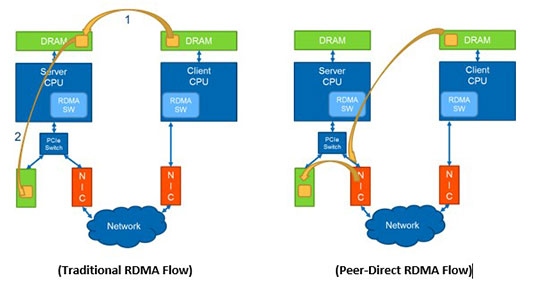With the big data, cloud computing and the Internet+, things booming,
SDN global telecom circles in recent years become one of the hottest topics. Huawei in its 2015 Cloud Computing Conference (HCC 2015) released a cloud data center for next-generation
data center network architecture - open cloud network architecture OCF (Open Cloud Fabric), through an open and decoupling of SDN network architecture enables cloud rapid business innovation.
SDN has become an inevitable trend, based on SDN's OCF create a new network architecture. It allows network further opening, from the top down to application-driven network, which is a big step forward network.
Network from the previous black box technology is moving towards open, otherwise it is impossible to match the application, computing, storage requirements driven by cloud, and Huawei in this respect walk in the forefront.
What is OCF?
Huawei definition of OCF, is a new data center network architecture, which is based SDN architecture thinking, the traditional closed network decoupled into data plane, control plane and service plane, three plane interworking via standard protocols, while highly compatible third-party products .
Open SDN program, has become the common needs of enterprises and industrial chain. A large number of companies are considering or are deploying SDN, the reason is very simple, cloud computing, big data, Internet+, the emergence of the Internet of Things requires the network to keep up with the support of various new applications. The existing network not flexible enough to meet the demand, SDN creates opportunities. Huawei's continuous investment in SDN field, Cloud Fabric from 2012's 1.0, 2014 2.0 2015 3.0, Huawei has been committed to promoting data center SDN development, OCF architecture announced today, will be long-term support data center SDN solve development programs.
Traditional network is closed, can not be dynamically adjusted according to user needs, and OCF through open protocols, will be adjusted to control the network and resources open to the user to achieve the best service by dynamically adjusting the control network.
OCF as demands for different types of open architecture client base in the data plane, provided by ONF OpenFlow 1.3 conformance certification of CloudEngine series data center switches, while facing the virtual network released a new generation CloudEngine 1800V virtual switch. In the control plane, the new release of cloud-oriented network Agile Controller 2.0 can achieve a unified policy management of physical and virtual networks and issued. In business plane, there will be more network applications to provide users, including network quality testing, safety-oriented policy definition applications and other business arrangement.
Future data center network will be decoupled and layered, future changes in the speed of data center operations will be in hours and minutes level, this rate is far unable to meet the needs of traditional networks, both in policy definition, network operations and management, and even business-oriented customization capabilities, the traditional networks have a great disadvantage. Huawei released OCF goal is to make the network more flexible and agile infrastructure, embrace cloud business changes.
OCF core components Highlights
OCF groundbreaking, and constitutes the core components of the same OCF many highlights. Among them, Huawei CloudEngine series switches get ONF certification issued by the OpenFlow 1.3, Huawei also became the first in the world and China's first manufacturer to obtain the certification. Testing and certification show, CloudEngine series switches meet the OpenFlow standard, enabling control and forwarding decoupling, and successful docking third party ODL, RYU, ONOS controller; at the same time, CloudEngine series switches support Hybrid model, can meet the networking needs of the traditional network , but also have the ability to OpenFlow network evolution model can help customers achieve a smooth upgrade legacy networks to SDN network, reducing network transformation risk and protect investments.
Huawei CloudEngine 1800V is for data center virtualization environments, distributed virtual switches, can be combined with Huawei CloudEngine series switches and Agile Controller controller hardware, to achieve a unified visualization and management of physical and virtual networks; at the same time, CloudEngine 1800V supports VMware, Microsoft, KVM and other mainstream virtualization platforms, and business unified bearer; in addition, it also supports the standardized northbound interfaces can be 1.0 / 1.3 interface and a variety of standard docking SDN controller through OpenFlow, the controller can also interface to it by OVSDB configuration and management.
Latest Agile Controller 2.0 is based on open architecture platform designed to meet the new generation of network-based SDN building aspirations. Agile Controller 2.0 provides the SDN architecture layered decoupling ability to achieve open interfaces and programmability based on business layer, and supports third-party docking mainstream cloud platform for network services automatically grant, its core functions include automated deployment, fine operation and maintenance and highly reliable clusters.
Industry for the realization of next-generation networks have different approaches, but the most critical is that the next hop of the network is open, open to innovation networks open opportunity for us to see more of the new stuff. And Huawei, our switches can be a third-party controller, our controllers can also be integrated, we hope to provide customers with a comprehensive open platform.
For customers, OCF open architecture brings tremendous value. OCF can provide external network open system-level capability, which is opening up the network as a whole, through the "physical Net + Virtual Network + controller" full open SDN solutions enable customers to build networks for their business demand, Achieving business agility to deploy, more refined operation and maintenance management, and more efficient use of resources, the overall cost savings ownership (TCO) while improving maintenance efficiency.
Open ecosystem of open architecture
Huawei has established around the OCF and cloud computing industry downstream partners on multiple levels of cooperation, and gradually build and enrich OCF industry ecosystem, allowing seamless integration of Internet and cloud IT, but also to play a more value, boosting cloud network calculate the user's business innovation. Currently, there are already a lot of partners' products and solutions are incorporated into Huawei's agile data center OpenLab open laboratory.
In the cloud operating system level, OCF has been achieved with Huawei FusionSphere, VMware, OpenStack, Microsoft and other mainstream cloud platform interoperability; network application level, and Puppet Labs, F5, Citrix and other network application vendors to cooperate; network security level, Huawei has been with the Checkpoint launch joint programs.
OpenLab is open ecosystem strategy we support, we will continue to SDN architecture in different levels of many manufacturers to include, from the bottom of the virtualization software to interconnection applications, controllers, not only from north to south, including the east-west It can be interconnected.
Huawei switches and general manager of the OSS product line Cheng Changqing field of corporate communications, said Huawei's network industry alliance partners to provide a good platform, based on the platform partners can publish their applications and products that can work together for customer acquisition and Huawei commercial success. Next, Huawei will further improve the developer environment, community technically allow partners to open faster and better user-oriented needs.
Currently, Huawei agile data center networking solutions Cloud Fabric has been successfully deployed in more than 80 countries around the world more than 1,000 data centers, SDN business partner is no lack of Century Internet, China Unicom, Tencent, Telefonica this global leader.














